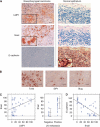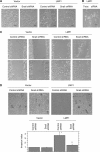Epstein-Barr Virus latent membrane protein 1 induces Snail and epithelial-mesenchymal transition in metastatic nasopharyngeal carcinoma
- PMID: 21386845
- PMCID: PMC3068490
- DOI: 10.1038/bjc.2011.38
Epstein-Barr Virus latent membrane protein 1 induces Snail and epithelial-mesenchymal transition in metastatic nasopharyngeal carcinoma
Abstract
Background: Epstein-Barr Virus (EBV)-associated nasopharyngeal carcinoma (NPC) is distinctive among head-and-neck cancers in its undifferentiated histopathology and highly metastatic character. We have recently investigated the involvement of epithelial-mesenchymal transition (EMT) in NPC. In a previous study, we found a close association of expression of LMP1, the principal EBV oncoprotein, with expression of Twist and induction of EMT.
Methods: We analysed expression of Snail in 41 NPC tissues by immunohistochemistry. The role of Twist as well as Snail in EMT of NPC was investigated by using NP69SV40T human nasopharyngeal cells.
Results: In NPC tissues, overexpression of Snail is associated with expression of LMP1 in carcinomatous cells. In addition, expression of Snail positively correlated with metastasis and independently correlated inversely with expression of E-cadherin. Expression of Twist had no association with expression of E-cadherin. Further, in a human nasopharyngeal cell line, LMP1 induces EMT and its associated cellular motility and invasiveness. Expression of Snail is induced by LMP1 in these cells, and small hairpin RNA (shRNA) to Snail reversed the cellular changes. By contrast, Twist did not produce EMT in these nasopharyngeal cells.
Conclusions: This study strengthens the association of EMT with the metastatic behaviour of NPC. These results suggest that induction of Snail by the EBV oncoprotein LMP1 has a pivotal role in EMT in NPC.
Figures




References
-
- Alexander NR, Tran NL, Rekapally H, Summers CE, Glackin C, Heimark RL (2006) N-cadherin gene expression in prostate carcinoma is modulated by integrin-dependent. Cancer Res 66: 3365–3369 - PubMed
-
- Ansieau S, Bastid J, Doreau A, Morel AP, Bouchet BP, Thomas C, Fauvet F, Puisieux I, Doglioni C, Piccinin S, Maestro R, Voeltzel T, Selmi A, Valsesia-Wittmann S, Caron de Fromentel C, Puisieux A (2008) Induction of EMT by twist proteins as a collateral effect of tumor-promoting inactivation of premature senescence. Cancer Cell 14: 79–89 - PubMed
-
- Barberà MJ, Puig I, Domínguez D, Julien-Grille S, Guaita-Esteruelas S, Peiró S, Baulida J, Francí C, Dedhar S, Larue L, García de Herreros A (2004) Regulation of snail transcription during epithelial to mesenchymal transition of tumor cells. Oncogene 23: 7345–7354 - PubMed
-
- Blanco MJ, Moreno-Bueno G, Sarrio D, Locascio A, Cano A, Palacios J, Nieto MA (2002) Correlation of snail expression with histological grade and lymph node status in breast carcinomas. Oncogene 21: 3241–3246 - PubMed
Publication types
MeSH terms
Substances
Grants and funding
LinkOut - more resources
Full Text Sources
Research Materials

